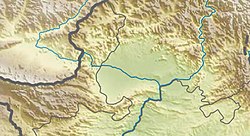Rukhuna reliquary
| Rukhuna reliquary | |
|---|---|
Bajaur, Pakistan. |
The Rukhuna reliquary, also sometimes Rukhana reliquary, also described as the Bajaur reliquary inscription, is a Scythian
Inscription
The inscription is very useful to clarify relative chronologies during the period. The inscription reads:
| Original (Kharosthi) | Transliteration | English translation |
|---|---|---|
| 𐨬𐨮𐨩𐨅 𐨯𐨟𐨬𐨁𐨭𐨩𐨅 𐩅 𐩃 𐩀 𐩀 𐩀 𐨀𐨁𐨭𐨿𐨤𐨪𐨯 | vaṣaye sataviśaye 20 4 1 1 1 iśparasa | In the twenty-seventh - 27 - of the lord |
| 𐨬𐨁𐨗𐨩𐨨𐨁𐨟𐨿𐨪𐨯 𐨀𐨤𐨕𐨪𐨗𐨯 𐨀𐨞𐨂𐨭𐨯𐨿𐨟𐨁𐨩𐨅 𐨩𐨅 𐨬𐨂𐨕𐨟𐨁 𐨀𐨩𐨯 | Vijayamitrasa Apacarajasa aṇuśastiye ye vucati Ayasa | Vijayamitra's, king of Apraca, rule, which is called Azes' |
| 𐨬𐨮𐨩𐨅 𐨟𐨿𐨪𐨅𐨯𐨟𐨟𐨁𐨨𐨀𐨅 𐩅 𐩅 𐩅 𐩄 𐩀 𐩀 𐩀 𐨩𐨆𐨞𐨞 𐨬𐨮𐨩𐨅 𐨀𐨅𐨐𐨡𐨂𐨭𐨟𐨁𐨨𐨩𐨅 | vaṣaye tresatatimae 20 20 20 10 1 1 1 Yoṇaṇa vaṣaye ekaduśatimaye | seventy-third - 73 - year, in the two-hundred-and-first year of the Greeks - |
| 𐩀 𐩀 𐩆 𐩀 𐨭𐨿𐨪𐨬𐨞𐨯 𐨨𐨯𐨯 𐨡𐨁𐨬𐨯𐨩𐨅 𐨀𐨛𐨨𐨩𐨅 𐨀𐨁𐨭 𐨡𐨁𐨬𐨯𐨎𐨨𐨁 𐨤𐨿𐨪𐨟𐨁𐨳𐨩𐨁𐨡𐨂 𐨠𐨂𐨬𐨅 | 2 100 1 Śravaṇasa masasa divasaye aṭhamaye iśa divasaṃmi pratiṭ́havidu thuve | 201 - in the month of Śrāvaṇa, on the eighth day, on that day is established a Stupa |
| 𐨪𐨂𐨑𐨂𐨞𐨩𐨅 𐨀𐨤𐨕𐨪𐨗𐨧𐨪𐨿𐨩𐨀𐨅 𐨬𐨁𐨗𐨩𐨨𐨁𐨟𐨿𐨪𐨅𐨞 𐨀𐨤𐨿𐨪𐨕𐨪𐨗𐨅𐨞 𐨀𐨁𐨎𐨡𐨿𐨪𐨬𐨪𐨿𐨨𐨅𐨞 𐨯𐨿𐨟𐨿𐨪𐨟𐨅𐨒𐨅𐨞 𐨯𐨧𐨪𐨿𐨩𐨪𐨅𐨱𐨁 𐨯𐨐𐨂𐨨𐨪𐨅𐨱𐨁 | Rukhuṇaye Apacarajabharyae Vijayamitreṇa Apracarajeṇa Iṃdravarmeṇa strategeṇa sabharyarehi sakumarehi | by Rukhuṇa, wife of the king of Apraca, by Indravarma , together with their wives and their sons.
|
In
vaṣaye sataviśaye 20 4 1 1 1 iśparasa
Apacarajasaaṇuśastiye ye vucati
"In the twenty-seventh - 27 - year in the reign of Lord
Apraca"
ayasa vaṣaye tresa⟨*ta⟩timae 20 20 20 10 1 1 1
"in the seventy-third - 73 - year which is called "of Azes""
Yoṇaṇa vaṣaye ekaduśatimaye 2 100 1
"in the two hundred and first - 201 - year of the Yonas (Greeks)"
Śravaṇasa masasa divasaye aṭhamaye iśa divasaṃmi pratiṭ́havidu thuve Rukhuṇaye Apacarajabharyae Vijayamitreṇa Apracarajeṇa Iṃdravarmeṇa strategeṇa sabharyarehi sakumarehi
"on the eighth day of the month of Sravana; on this day was established [this] stupa by Rukhuna, the wife of the King of
This dedication also indicates that King Vijayamitra and his wife Rukhuna were
Since Vijamitra is said to have ruled 27 years already, his reign started in 12 BCE, and ended probably a few years after the dedication took place, around 20 CE.
The authenticity of the inscription is nearly unanimously accepted by the academic community, Gérard Fussman being a dissenting voice.[10]
Similar examples of reliquaries
-
Another similar example: the Bimaran casket. This reliquary is inscribed on the outside, rather than the inside.
-
Broadly similar stone containers with compartments from Ai-Khanoum, 2nd century BCE.[11]
-
Stone vessels (pyxides) from the Temple with niches, Sanctuary of Ai-Khanoum, 3rd-2nd century BCE.[11]
Notes
- ^ ISBN 978-2-503-51681-3.
- ^ Des Indo-Grecs aux Sassanides: données pour l'histoire et la géographie historique, Rika Gyselen, Peeters Publishers, 2007, p.109 [1]
- ISBN 9782952137614.
- ^ Baums, Stefan. (2012). Catalog and Revised Text and Translations of Gandhāran Reliquary Inscriptions. Gandhāran Buddhist Reliquaries. D. Jongeward. Seattle, University of Washington Press
- ^ "Afghanistan, carrefour en l'Est et l'Ouest" p.373. Also Senior 2003
- ^ Des Indo-Grecs aux Sassanides, Rika Gyselen, Peeters Publishers, 2007, p.103 [2]
- ^ "Silk Road Art and Archaeology". Journal of the Institute of Silk Road Studies, Kamakura. 9. The Institute: 49. 2003.
- ^ Baums, Stefan. 2012. “Catalog and Revised Texts and Translations of Gandharan Reliquary Inscriptions.” In David Jongeward, Elizabeth Errington, Richard Salomon and Stefan Baums, Gandharan Buddhist Reliquaries. Gandharan Studies, Volume 1, pp. 200–51. Seattle: Early Buddhist Manuscripts Project.
- ^ Fussman, Gérard. The riddle of the ancient eras is not yet solved (PDF). p. 242.
- ^ Fussman, Gérard. The riddle of the ancient eras is not yet solved (PDF). pp. 239–259.
- ^ a b Falk, Harry (2015). Buddhistische Reliquienbehälter aus der Sammlung Gritli von Mitterwallner. p. 135.
References
- Baums, Stefan. 2012. “Catalog and Revised Texts and Translations of Gandharan Reliquary Inscriptions.” In: David Jongeward, Elizabeth Errington, Richard Salomon and Stefan Baums, Gandharan Buddhist Reliquaries, pp. 212–213, Seattle: Early Buddhist Manuscripts Project (Gandharan Studies, Volume 1).
- Baums, Stefan, and Andrew Glass. 2002– . Catalog of Gāndhārī Texts, nos. CKI 405
- Senior, R.C. (2006). Indo-Scythian coins and history. Volume IV. Classical Numismatic Group, Inc. ISBN 0-9709268-6-3.
- Richard SALOMON, "A New Inscription dated in the "Yona" (Greek) Era of 186/5 B.C." in Afghanistan, ancien carrefour entre l'est et l'ouest, O. Bopearachchi, M.-F. Boussac (eds.), 2005, ISBN 978-2-503-51681-3 Languages: French, English [3]


![The Darunta reliquary from Passani Stupa No.2 is structurally similar to the Rukhuna reliquary, especially with the inside compartments.[1]](http://upload.wikimedia.org/wikipedia/commons/thumb/2/23/Darunta_steatite_container.jpg/74px-Darunta_steatite_container.jpg)

![Broadly similar stone containers with compartments from Ai-Khanoum, 2nd century BCE.[11]](http://upload.wikimedia.org/wikipedia/commons/thumb/a/a4/PlatesAiKhanoum.jpg/120px-PlatesAiKhanoum.jpg)
![Stone vessels (pyxides) from the Temple with niches, Sanctuary of Ai-Khanoum, 3rd-2nd century BCE.[11]](http://upload.wikimedia.org/wikipedia/commons/thumb/2/23/AiKhanumVessel.jpg/120px-AiKhanumVessel.jpg)